Oracle Integration is a robust platform that allows enterprises to connect and automate business processes across various industry use cases. To help customers jump-start the business automation journey, Oracle Integration provides a rich prebuilt solution library. You can find more information about the prebuilt solution library here. Oracle Cloud Infrastructure provides a plethora of compelling AI services that can be further used to automate and streamline business processes. In this blog, I will talk about some of the use cases that you can automate using Oracle Integration and OCI AI services. The best part is that these solutions are already available in the form of prebuilt solutions for easy consumption. Let’s now dive deeper into AI-powered business automation solutions.
Automate Invoice Processing
Do you have the tedious task of reviewing documents such as invoices, driving licenses, and others, and manually entering data into back-end ERP applications? If the answer is yes, this prebuilt solution is a game-changer for you. Let’s say you receive a vendor invoice through an email, and have a user (buyer persona) manually enter the invoice as received on the backend ERP application. Once the invoice is created, it goes through approval from different teams and is later released for payment.
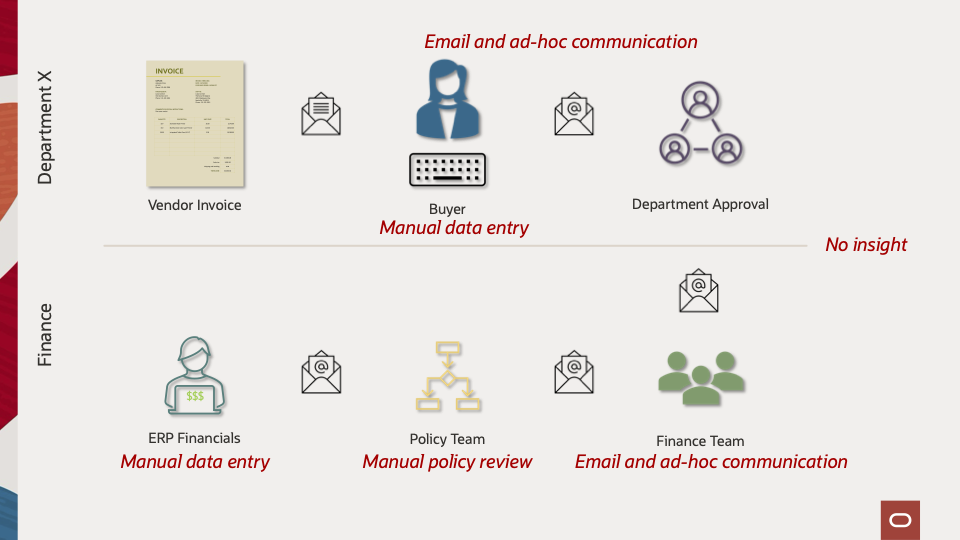
The main challenges in this manual, tedious business process are that it lacks visibility into where the process is currently stuck, is highly inefficient, and is prone to manual data entry errors. It would be good if you could innovate with AI and automate your business process to bring all the clarity and efficiency that is required. It is too good to be true, but it is possible to do so right now. Let’s now take a look at how you go about it.
This whole process is easily automated by using the Oracle Integration business automation tool kit. You can first use the Google Gmail Adapter to read emails, next use the OCI Document Understanding native action to extract data from the unstructured data such as an invoice PDF, and finally use human workflow/decision service/connectivity to streamline the business process end-to-end.
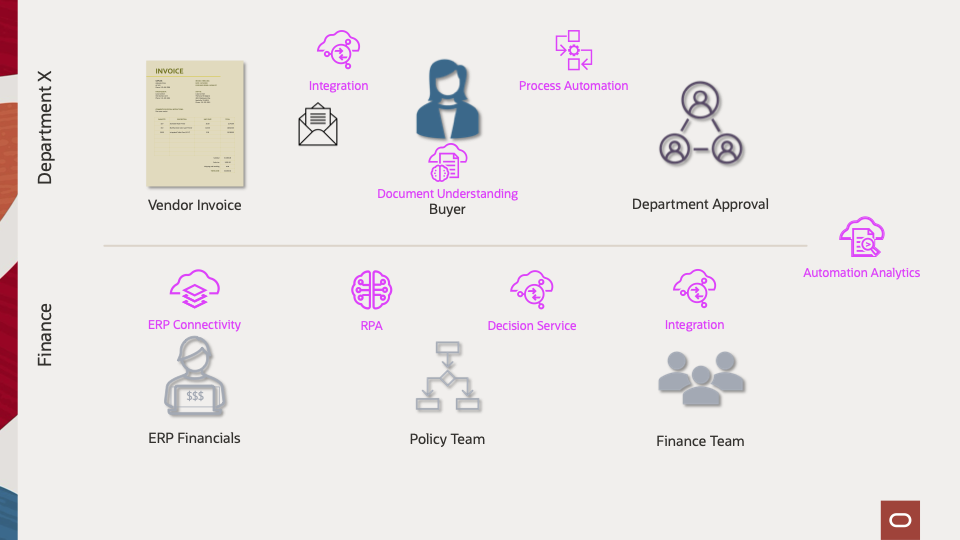
In this case, we spoke about invoices. However, it can also be a KYC requirement where users are sending you an email with the KYC document and you need to update their status in the backend application. All such business processes can now be easily automated, streamlined, and enhanced by leveraging the Oracle Integration business automation tool kit along with AI services such as OCI Document Understanding.
Let’s now talk about the existing prebuilt solutions that are available to you OOTB from the Oracle Integration store.
- Create Invoices in Oracle ERP Cloud Using OCI Document Understanding AI Service
- Extract Data from Unstructured Files Using OCI Vision
- Send Automatic Replies to Emails with a Specific Subject Using Oracle AI
Let’s dive deeper into the first prebuilt solution to understand how exactly the solution is built.
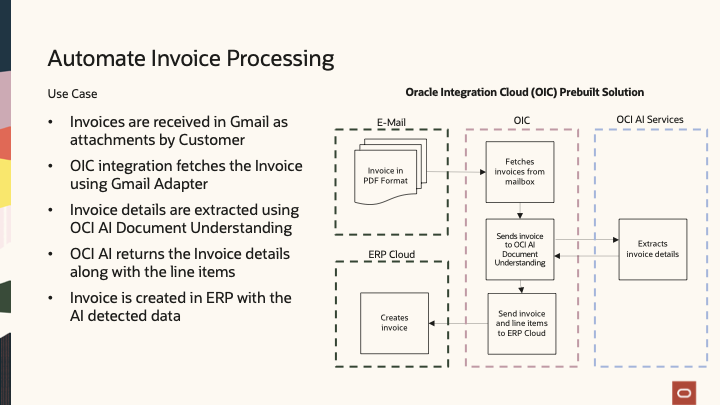
As you can see from the above summary, we first read an email using the Google Gmail Adapter. Once the email is read, we pass the invoice attachment to the OCI Document Understanding native action. Oracle Cloud Infrastructure (OCI) Document Understanding is an AI service that enables developers to extract text, tables, and other key data from unstructured document files. With the OIC 25.04 release, OCI Document Understanding is a first class native action in the integration canvas. To learn more about the OCI Document Understanding native action, see this blog and the user guide.
In the first release of the OCI Document Understanding native action, Oracle Integration supports the following document types to read content from:
- Invoice
- Receipt
- Driving License
- Passport
In future releases, Oracle Integration will add support for using even more custom models from which to read your document contents.
The next prebuilt solution is to extract data from an unstructured PDF document using OCI Vision. This prebuilt solution demonstrates how you can read an element from specific locations in an unstructured document such as PDF/images and extract the text. Let’s say you receive a number of PDF files from vendors at an sFTP location, and need to rename the files based on the invoice number that is available in the PDF at specific locations. Here is the graphical overview of how the solution is built in Oracle Integration:
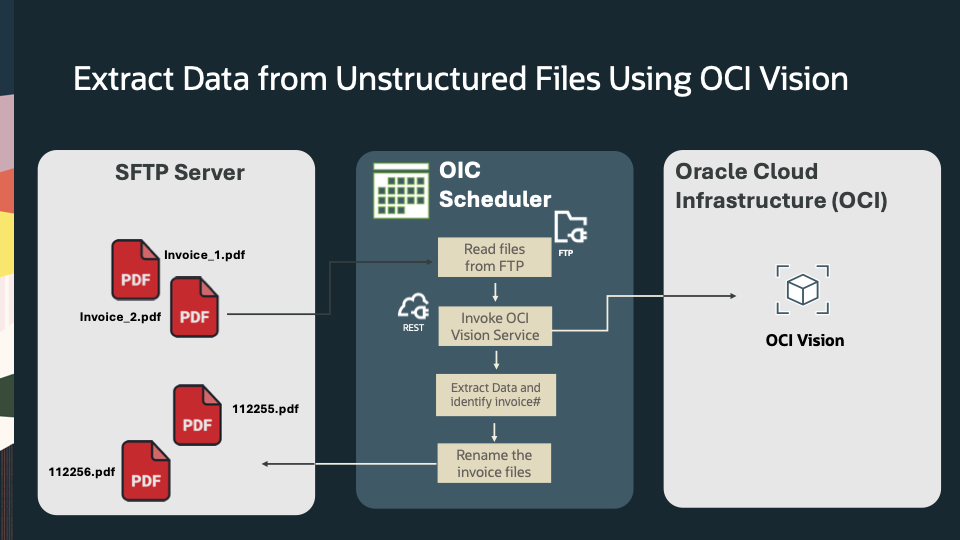
As you can see from the above summary, once the file is read from the sFTP location, Oracle Integration uses the REST Adapter to invoke the OCI Vision service to read the invoice number from a specific location. Once the invoice number is read, it renames the file with the invoice number.
OCI Vision can be used for many use cases, such as:
- Image classification
- Object detection
- Face detection
- Text detection
You can also train a custom model and use it as part of the automation solution. For now, you need to interact with the OCI Vision service through REST APIs. Oracle Integration is working on native action support for the OCI Vision service that will greatly simplify how you interact with it.
Let’s now talk about one more AI prebuilt solution that is available right now for you to use: Send Automatic Replies to Emails with a Specific Subject Using Oracle AI. This prebuilt solutions allows you to read email from an email server and generate an automatic reply for unread mails using OCI AI services. Let’s take a look at a high-level overview of the solution:
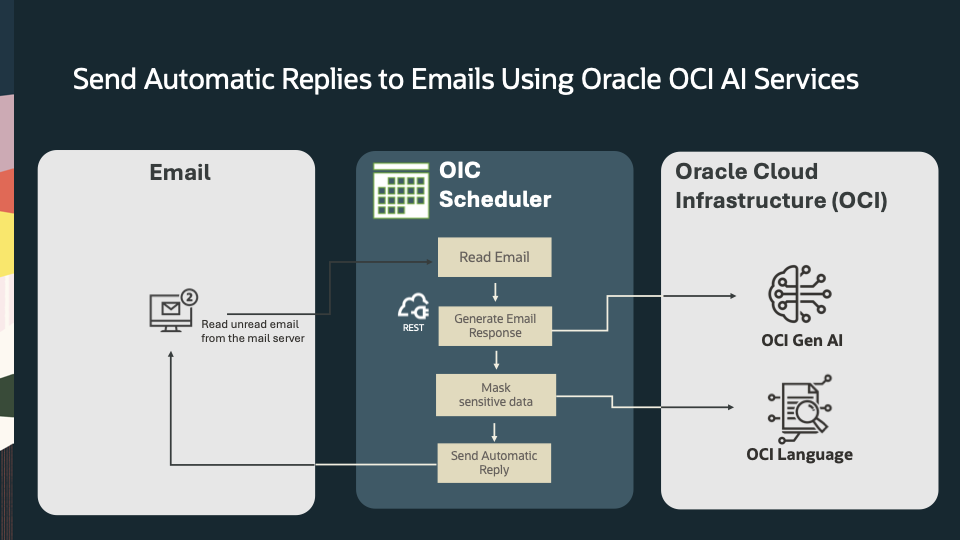
As you can see from the above summary, we use multiple OCI AI services. The OCI Gen AI service is first used to generate the automatic response, and the OCI Language service is later used to sanitize the personal identifiable information from the automatic reply. Again as of now, the prebuilt solution is using the REST Adapter to invoke the OCI Gen AI and OCI Language APIs to achieve the objective. In an upcoming release, Oracle Integration will release native actions for these OCI AI services to further improve the integration developer experience.
This completes our blog on the current AI prebuilt solutions that are live and already available in the Oracle Integration store. You can search for them here. We will continue to blog about more and more AI automation solutions using Oracle Integration. I hope you found this blog useful and will use these prebuilt solutions to accelerate your time to market.
